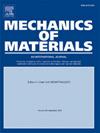声致磁-电弹性纳米球的增广表面阻抗理论与太赫兹纳米天线应用
IF 4.1
3区 材料科学
Q2 MATERIALS SCIENCE, MULTIDISCIPLINARY
引用次数: 0
摘要
预测纳米磁电弹性(MEE)天线和谐振器在入射声波下的行为需要仔细考虑多物理场表面/界面效应,包括磁化、极化和弹性。迄今为止,还没有一种解析解能同时包含这三种现象。通过解决这些表面效应,本工作对入射声波下的纳米球形各向同性嵌入MEE球壳进行了严格的数学分析。将有关MEE球壳体积的耦合谱本构关系集与有关其自由内表面和基壳界面的耦合谱本构关系集进行了区分。所述周围基质可由各向同性电介质或金属材料组成。传统的电动力学理论不足以解决这个问题,因为它们不能充分解释表面或界面上的MEE效应。为了克服这一局限性,本研究采用等效阻抗矩阵(EIM)方法结合表面/界面弹性来严格模拟表面/界面MEE行为。对于金属基体,利用等离子体模型描述的光学特性,利用基于等离子体的数学框架精确捕捉金属的行为。谱EIM方法结合矢量和张量球面谐波构成单位球上平方可积矢量场和二阶对称张量场的Schauder基,是求解完全耦合弹性动力学和麦克斯韦方程组的关键工具。这种方法在捕获重要的MEE表面/界面效应方面特别有效。该方法可以详细探索表面/界面特征长度,便于检查尺寸对电磁辐射功率和基共振频率的影响。这些发现为基于MEE纳米球的声驱动纳米球形天线、纳米传感器和纳米谐振器的行为提供了有价值的见解。此外,这些结果对纳米级器件的设计和优化具有重要意义。本文章由计算机程序翻译,如有差异,请以英文原文为准。
An augmented surface impedance theory for acoustically actuated magneto-electro-elastic nanospheres with terahertz nanoantenna applications
A precise analytical treatment for predicting the behavior of nano-sized magneto-electro-elastic (MEE) antennas and resonators under incident acoustic waves requires careful consideration of multiphysics surface/interface effects, including magnetization, polarization, and elasticity. To date, no analytical solutions have incorporated all three phenomena simultaneously. By addressing these surface effects, this work presents a rigorous mathematical analysis of a nano-sized spherically isotropic embedded MEE spherical shell subjected to incident acoustic waves. The set of coupled spectral constitutive relations relevant to the bulk of the MEE spherical shell is distinguished from those pertinent to its free inner surface and matrix-shell interface. The surrounding matrix may consist of an isotropic dielectric or metallic material. Conventional electrodynamics theories are insufficient to address this problem, as they do not adequately account for MEE effects at the surface or interface. To overcome this limitation, the study employs the equivalent impedance matrix (EIM) method combined with surface/interface elasticity to model the surface/interface MEE behaviors rigorously. For metallic matrices, a plasmonics-based mathematical framework is utilized, with the optical properties described by the plasma model to accurately capture metallic behavior. The spectral EIM method, combined with vector and tensor spherical harmonics forming a Schauder basis for square-integrable vector fields and second-rank symmetric tensor fields on the unit sphere, is shown to be a pivotal tool for solving the fully coupled elastodynamics and Maxwell’s equations. This approach is particularly effective in capturing significant MEE surface/interface effects. This methodology enables a detailed exploration of surface/interface characteristic lengths, facilitating the examination of size-dependent effects on electromagnetic radiated power and fundamental resonance frequency. The findings provide valuable insights into the behavior of acoustically actuated nanospherical antennas, nanosensors, and nanoresonators based on MEE nanospheres. Moreover, these results have significant implications for the design and optimization of nanoscale devices in advanced technological applications.
求助全文
通过发布文献求助,成功后即可免费获取论文全文。
去求助
来源期刊

Mechanics of Materials
工程技术-材料科学:综合
CiteScore
7.60
自引率
5.10%
发文量
243
审稿时长
46 days
期刊介绍:
Mechanics of Materials is a forum for original scientific research on the flow, fracture, and general constitutive behavior of geophysical, geotechnical and technological materials, with balanced coverage of advanced technological and natural materials, with balanced coverage of theoretical, experimental, and field investigations. Of special concern are macroscopic predictions based on microscopic models, identification of microscopic structures from limited overall macroscopic data, experimental and field results that lead to fundamental understanding of the behavior of materials, and coordinated experimental and analytical investigations that culminate in theories with predictive quality.
 求助内容:
求助内容: 应助结果提醒方式:
应助结果提醒方式:


